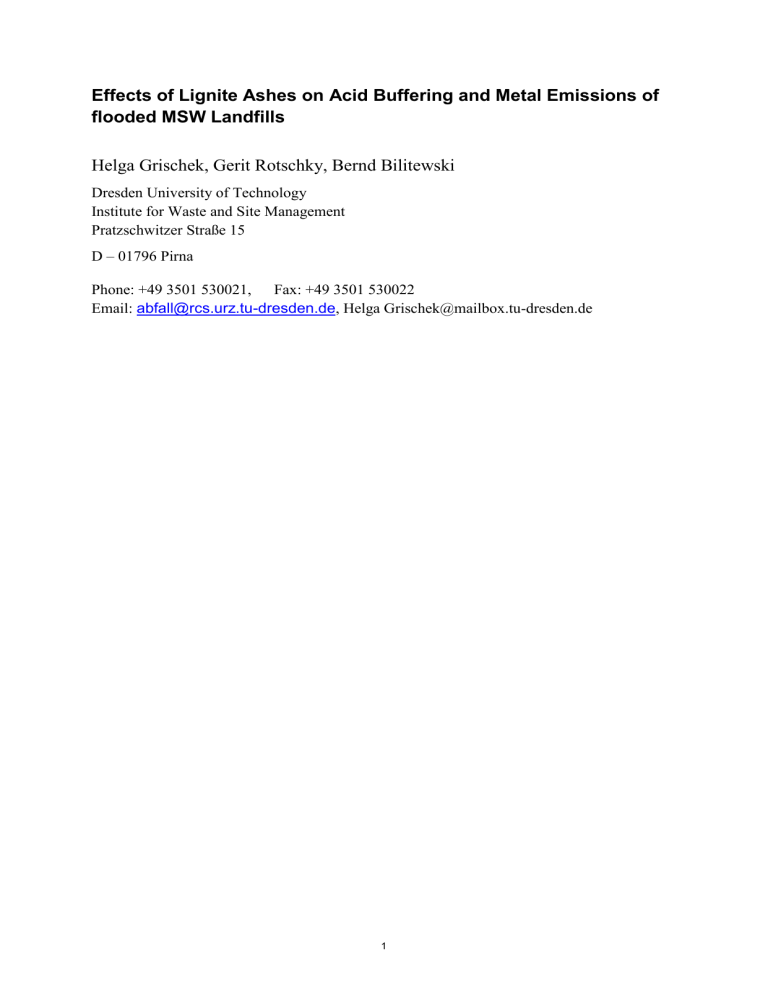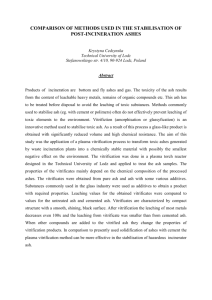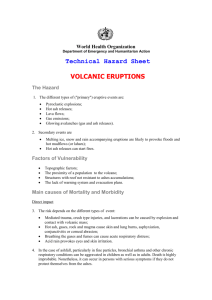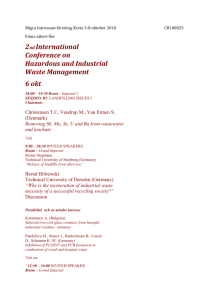Acid Buffering of Lignite Ashes

Effects of Lignite Ashes on Acid Buffering and Metal Emissions of flooded MSW Landfills
Helga Grischek, Gerit Rotschky, Bernd Bilitewski
Dresden University of Technology
Institute for Waste and Site Management
Pratzschwitzer Straße 15
D – 01796 Pirna
Phone: +49 3501 530021, Fax: +49 3501 530022
Email: abfall@rcs.urz.tu-dresden.de
, Helga Grischek@mailbox.tu-dresden.de
1
Abstract : Lignite ashes are very important for acid buffering processes in MSW landfills that are flooded with acidic water. They can prevent acidification for at least some hundred years.
Lignite ashes have a high ANC which correlates with the contents of earth alkali metals and inorganic carbon. Calcite from carbonation with athmospheric CO
2
, active Ca-Al-glasses and aluminium compounds were found to be the main buffering substances. The release of metals from lignite ashes increases significantly with decreasing pH due to the dissolution of buffering substances as well as of easily soluble salts. Aluminium has an amphoteric character, whereas iron compounds are barely soluble even at very low pH values. Heavy metal fixating effects of the lignite ashes could not be found out under the pH-static elution conditions. Under full scale conditions fixation by sorption, precipitation and ion exchange processescan be expected to have a greater importance.
Key words: landfill, abandoned open pits, acidic mine drainage, lignite ashes, acid buffering,
ANC, pHstatic elution tests, heavy metals
1.
Introduction
In the area of the Lausitz in the East of Germany, lignite has been mined in open pits for more than a hundred years. For this purpose the groundwater table in an area of more than 2000 km² has been lowered by up to 100 metres (Kinze, 1997). The pyrite and markasite containing overburden was removed away and in this way aerated. The weathering of these FeS
2
minerals results in a high acidification potential of the overburden dumps, which is released in the contact with water and oxygen (equation 1)
2 FeS
2
+ 7 H
2
O + 7,5 O
2
2 Fe(OH)
2
+ 4 SO
4
2-
+ 8 H
+
(eq. 1)
Due to the decrease in lignite mining from the beginning of the 1990ies, the reduction in groundwater pumping has caused the water table and mining lakes to rise. The regional groundwater has a high acidification potential at pH values of 5,0 to 7,0, whereas the mining lakes are very acidic with pH-values as low as 2,0. The intention of the concept for rehabilitating the water balance and water quality of the Lausitz region is to reach final water levels and pH values of > 6,0 in the surfacewater within several decades (LMBV, 1997).
The exploited open pits were used for landfilling waste. These mostly small landfills, containing mainly municipal solid waste are now subject of flooding with ground- and surfacewater. They were operated without basing liners or any other technical protection.
According to the landfilling practices in the GDR, the landfills were filled slowly and with little compaction.
The long-term emission behaviour and hazard potential of unsaturated old East German landfills was investigated by Andreas et. al (1997, 1999). The results show that the emission potentials of C- and N-compounds are low in comparison with those of old landfills in
Western Germany. Sulphate reducing processes were found to be the main mechanism of biochemical degradation. The sulphate derives mainly from lignite ashes. The proportion of these ashes in old East German landfills is high due to the briquette heating in most of the
2
GDR households. The amount of ashes, that went to the landfill together with municipal solid waste, can be estimated to approximately 10 Mt per year for the whole GDR territory
(Blankenburg, 1986). Another compound that was landfilled in the Lausitz area in large quantities (up to 10 Mt per year) was lignite fly ash from the big power plants.
The aim of the presented study was:
to investigate the elemental and mineralogical composition of lignite ashes,
to determine the acid neutralizing capacity ANC of lignite ashes and to characterize the main components responsible for acid buffering,
to investigate the effects of lignite ashes on metal mobility, and
to describe the influence of lignite ashes in flooded MSW landfills, with regard to their acidification and the subsequent enforced release of metals from the landfill to the mining lake.
2.
Material and Methods
Four ash samples, a fresh waste sample and two mixed fresh waste/ash samples as described in Table 1 were investigated.
Table 1: Description of the samples sample origin description
Ash 1 ash from household heating, stored for several weeks very fine-grained red ash, soot particles in fraction > 2 mm
Ash 2
Ash 3
Ash 4 fresh waste (FW)
FW/Ash 2
FW/Ash 3 ash from household heating, stored for 9 months fly ash from Dresden Heating Station, dumped on a mono-landfill for 10 years very fine-grained red ash, unburned wood, soot and slag particles in fraction
> 2 mm very fine-grained grey ash, cement-like solidified grate ash from an industrial power station, dumped on a mono-landfill for several decades fine-grained black ash, slag and lignite particles in fraction > 2 mm municipal solid waste from an urban area Overwhelming plastics, Verbund , paper, organics, very few fine grained material
50 % fresh waste, 50 % ash from household heating
50 % fresh waste, 50 % fly ash from power station
The following investigations were made on the ash samples:
Solid phase analyses on grain fractions: TIC, S, Ca, Mg, Al, Fe
Mineralogical investigations (X-ray-Diffraction, thermoanalysis),
pHstatic elution test to establish a buffer curve to pH 3,0 (continious addition of HNO
3
),
leachate analyses at several pH values: Ca, Mg, Al, Fe, SO
4
2-
, DIC, Pb, Zn.
3
3.
Results
3.1 Solid phase analyses and mineralogical investigations
Figure 1 shows the elemental composition of the ashes. There are strong differences between the samples. Ash 1 and Ash 2 from household heating were similiar. They contained the highest concentrations of calcium, magnesium, iron and sulphur. The contents of TIC show the influence of storage. Ash 1 stored for 9 months, had a clearly higher TIC than the fresh
Ash 2. This carbonation effect can be described as the formation of calcite from calcium compounds. It has been investigated for MSW incineration slags and ashes. Carbonation during storage is an important factor for the landfilling of these materials since carbonate buffering is the most capable mechanism for preventing metals from being released as a result of contact with acid rain (Förstner, 1997). Gade et. al (1999) found that under open storage conditions carbonation of MSW incineration slag takes about 3 months After that the reaction rates decrease significantly. From this fact can be estimated, that the carbonation of Ash 1 was more or less complete.
Ashes 3 and 4 contained less calcium, magnesium, iron and sulphur. Ash 3 contained the highest concentration of aluminium. The TIC of Ash 3 consisted of calcite and tilleyite. The low value indicates that the calcite has been partly washed out under landfill conditions. Ash
4 had a high TIC, although mineralogical investigations and carbonate analyses showed that this did not originate from calcite.
Ash 1
Ash 2
143
164
41
56
171
178
24 80 16
43 41 3
Ash 3 78 61 54 22 3
Ash 4 25 60 26 20
Ca Mg Fe Al S TIC
0 100 200 g/kg
300 400 500
Figure 1: Elemental composition of the ashes
Table 2 gives the stock of mineralogical phases in the crystalline part of the samples. The glassy phase, which is estimated in the literature to be about 70 %, could not be quantified.
Lignite ashes consist predominantly of quartz, earth alkali compounds, iron oxides and Alsilicates, so called active Ca-Al- and inert Fe-Al-glasses, respectively (Kautz, 1986).
4
Table 2: sample
Stock of mineralogical phases in the crystalline part of the samples
Ash 1
Ash 2
+
+
+
+
+
+
+++
+++
Ash 3 +++ + +
Ash 4 +++ + (+)
Legend: +++ main component
+ secondary component
(+)
(+)
(+)
(+) +
(+) + trace component
(++) existing, not quantified
+ (++)
(++)
(++)
(++)
Ashes 1 and 2 from household heating were dominated by anhydrite CaSO
4
, while Ashes 3 and 4 from power stations were dominated by quartz. The reason for these significant differences can be found in the fuel composition and in combustion technology. Whereas briquettes for the household heating contain few impurities, power stations use raw lignite with a higher proportion of sand. The higher combustion temperature in power stations of at least 1000 °C causes a melting of ash components, while the swift cooling down of the ashes prevents the formation of crystalline mineral phases. Hence most phases are glass-like, only quartz remaining in the crystalline phase in significant amounts. With household heating at about 600 °C and slow cooling down the ashes can solidify in crystalline phases and new compounds like brownmillerite can originate.
Iron minerals and calcite could be detected in all samples. Calcite was found to derive mainly from carbonation with atmospheric CO
2
during storage or landfilling. Ash 4 contained calcite only as a trace component, the inorganic carbon of this sample is expected to be found in the glassy phase.
3.2 Acid buffering of the ashes
Figure 2 shows the buffer curves and the ANC-values at pH 3,0 for the investigated ash samples and for pure fresh waste FW.
It is to be seen that ashes from household heating (Ash 1, Ash 2) had the highest ANC, and buffered at higher pH values than ashes from power stations (Ash 3, Ash 4). While Ash 3 reached a high ANC at pH 3,0, Ash 4 obviously had a very low capability for acid buffering.
In the strongly alkaline area above pH 8,0 calcium compounds (probably Ca-silicates, C-S-H and C-A-S-H phases) are primarily responsible for the acid buffering. The fresh Ash 1 obviously contained more of these compounds than the stored Ash 2. In the stored or landfilled ashes (Ash 2, Ash 3) these compounds probably had been carbonated already. The buffering by carbonates (primarily calcite) at a slightly increased partial pressure of CO
2
takes
5
place between pH 8,0 and 6,0 approximately. The ANC of Ash 1 and Ash 2 then correlated with the TIC of the samples. The TIC of Ash 3 derived probably partly from tilleyite, which is less soluble than calcite. Ash 4 did not show any remarkable ANC between pH 8,0 and 6,0.
The acid buffering between pH 8,0 and 6,0 was not only caused by calcite, between pH 8,0 and 5,0 active glasses (Ca-Al-silicates), and between pH 8,0 and 3,0 ion exchange processes with protons H
+
also were of importance. The ANC of the ashes was also found to be a question of particle size distribution, determining the availability of buffering substances. The ashes from household heating (Ash 1, Ash 2) with the highest ANC values were very fine grained. Below pH 4,0, aluminium compounds are responsible for buffering. The buffering in this pH area correlated with the aluminium contents of the ashes. Ash 2 and Ash 3 showed a clearly visible plateau and the highest ANC between pH 4,0 and pH 3,0. Buffering by iron compounds below pH 3,0 is important only for mining lakes with low buffer capacities. A decrease to this extreme value in systems with higher buffer capacities will rarely occur.
11,0
10,0
9,0
8,0
7,0
6,0
5,0
4,0
3,0
2,0
0
Figure 2:
Ash 1
Ash 2
Ash 3
Ash 4
FW
6000
4000
2000
0
ANC pH 3,0 (meq/kg DS)
6980
5840
5190
1460
840
Ash 1 Ash 2 Ash 3 Ash 4 FW
1000 2000 3000 4000
ANC in meq/kg DS
5000 6000 7000
Buffer curves of the ashes, established by pHstatic elution tests with continuos addition of HNO
3
3.3 Leachate
During the pHstatic elution tests leachate samples were analyzed at alkaline, neutral and acidic pH values to investigate the pH dependency of the release of metals, sulphate and DIC.
Figure 3 shows the release of calcium, magnesium, aluminium, iron, sulphate and DIC.
Table 3 gives the maximum elution rates.
The metals were released increasingly with decreasing pH. The ascent of the curves for calcium and magnesium was quite linear. The high elution rates showed, that calcium in particular and also Magnesium derived from more or less easily soluble salts. CaSO
4
, as an example was detected by mineralogical investigations.
The release of aluminium showed an amphoteric character. It was released at high pH > 9,0 and particularly at pH < 4,0. Iron was released mostly at very low pH values < 3,0, deriving from barely soluble compounds. The elution rates of aluminium and iron were clearly lower
6
than those of calcium and magnesium.
The release of sulphate did not depend on the pH. The elution rates obviously were limited only by saturation of the leachate.
The release of DIC showed maximal values at neutral pH. At pH < 4,0 the concentrations in the leachate were low, because CO
2
was produced and left the system, according to the
Dissolved Carbon Equilibrium.
Calcium
80
60
40
20
0
11,0
100000
10000
1000
100
10
1
11,0
9,0
9,0 7,0 pH 5,0
Sulphate
40
7,0 pH 5,0
Aluminium
3,0
3,0
1,0
0
11,0
1,0
30
20
10
10000
1000
100
1,2
10
1
11,0
Ash 1
Ash 2
Ash 3
Ash 4
9,0
9,0
Magnesium
7,0 pH
5,0
Iron
7,0 pH 5,0
DIC
3,0
3,0
1,0
1,0
30
0,8
20
10
0,4
0
11,0
Figure 3:
9,0 7,0 pH 5,0 3,0 1,0
0,0
11,0 9,0 7,0 pH 5,0 3,0 1,0
Release of calcium, magnesium, aluminium, iron, sulphur from sulphate and DIC in pHstatic elution tests
7
Table 3: in %
Calcium
Magnesium
Aluminium
Iron
Sulphur
Maximum elution rates of calcium, magnesium, aluminium, iron and sulphate from ash samples in the pHstatic elution tests
Ash 1
52
57
33
24
-
Ash 2
57
52
0,89
0,31
27
Ash 3
86
40
31
0,66
47
Ash 4
95
35
3,6
0,44
51
4. Influence of lignite ashes on the acid buffering of landfills
The buffer curves show clearly that lignite ashes have a positive effect on the acid buffering of a MSW landfill in general. On the base of a groundwater model by RAVON (1997) periods of time were estimated, until pH < 6,0 is reached in a flooded MSW landfill due to the influx of acidic water. A pH value of 4,0 of the water entering can be regarded as an extreme case, therefore the time periods are minimal values. Table 4 gives the time periods for pure ash and for ash contents of a MSW landfill of 1 %, 10 % and 30 %.
Table 4: Time periods until pH 6,0 is reached in a flooded with acidic water (pH = 4,0) landfill for pure ash and for ash contents of 1 %, 10 % and 30 % of the landfill
Ash 1 Ash 3 Ash 4
Ash content of the landfill
Pure ash
1 % ash, 99 % FW
10 % ash, 90 % FW
30 % ash, 70 % FW
32.400
1.100
3.900
10.300
Ash 2 time (in years)
44.800
1.200
5.200
14.000
18.400
900
2.600
6.200
1.300
750
810
920
As to be seen, the acidification of a flooded landfill is to be expected only in the long term of at least several hundred years. With rising ash contents of a landfill, the time until a low pH of 6,0 is reached, gets clearly longer. The concept referred to for the rehabilitation of water balance and water quality for the Lausitz region intends that a pH of > 6,0 in the surface water should be reached in the time-scale of several decades (LMBV, 1997). The pH in flooded
MSW landfills will not decrease significantly in this time period.
5. Influence of Lignite Ashes on the metal release from landfills
Elution tests with mixed fresh waste/ash samples were made to obtain information about the effects of lignite ashes on the mobility of heavy metals. Figure 4 shows the release of lead and zinc from samples containing 50 % fresh waste and 50 % ash respectively.
8
1,00
0,75
0,50
0,25
Lead
1000
100
10
FW
Ash 2 + FW
Ash 3 + FW
Zinc
0,00
11,0
Figure 4:
9,0 7,0 pH
5,0 3,0 1,0
1
11,0 9,0 7,0 pH 5,0 3,0 1,0
Release of lead and zinc from fresh waste and mixed fresh waste/ash samples in pHstatic elution tests
It is to be seen that there are almost no differences between the release from pure waste samples and mixed samples, though the mixed samples contained only the half of fresh waste, and the ashes contained very low concentrations of heavy metals. The ashes, under turbulent flow conditions of the pHstatic elution test were not able to fix heavy metals. In a full scale flooded landfill with laminar flow, the contact between solid and liquid phase will not be that intensive as in the pHstatic elution test. Heavy metal fixation effects, like sorption, precipitation and ion exchange can be expected to be of greater importance. Revans et. al
(1999) found in column tests that sorption and precipitation, probably mainly at ochre minerals prevented the heavy metal release from aerated old MSW.
6. Summary
Lignite ashes are of high importance for the acid buffering of flooded MSW landfills. Fresh and stored ash from household heating and fly ash from a power station showed a high capability for acid buffering. Grate ash landfilled for several decades, on the other hand, had a very low capability for acid buffering.
Since the ANC values correlated well with the contents of earth alkali metals (predominantly calcium), the capability for acid buffering of an unknown material can be roughly estimated from its contents of calcium, magnesium and aluminium. The composition of lignite ashes strongly depends on the fuel quality and on the combustion conditions. Calcite resulting from the carbonation of calcium compounds was found to be one of the important buffering substances in lignite ashes. Furthermore, Al-Silicates (e.g. active Al-Ca-glasses ) in the pH area between 8,0 and 5,0 as like as aluminium and iron compounds at pH < 4,0 were found to be of importance. The ANC was also found to be a question of particle size distribution, determining availability of buffering substances and the extent of ion exchange processes (between pH 8,0 and 3,0).
The release of metals increased with decreasing pH value. The release occurred in accordance to the dissolution of buffering substances. Calcium and magnesium, additionally, were released from easily soluble compounds. Aluminium was released particularly at pH< 4,0.
9
Iron was released mostly to a very low degree, obviously the iron compounds being barely soluble. In the elution tests, due to turbulent flow conditions, there could not be stated a positive, i.e. fixating influence of the ashes on heavy metals. Under the conditions of a flooded landfill, at laminar flow conditions, metal fixation by sorption, precipitation and ion exchange can be expected to be of greater importance.
In MSW landfills containing lignite ashes and flooded with acid water, pH values < 6,0 are not to be expected within a time period of some centuries. Consequently, a significantly increased release of metals from flooded MSW landfills will not occur.
References
Andreas L. (2000) Langzeitemissionsverhalten von Deponien für Siedlungsabfälle in den neuen Bundesländern
(Characterization of the long term emissions from MSW landfills in the New Federal States of Germany).
Dissertation, TU Dresden
Andreas, L., Conrad, H., Bilitewski, B. (1997) Emissionspotential sowie Langzeitverhalten von Siedlungsabfällen/Altablagerungen in den neuen Bundesländern (Emission potential and long term emissions of MSW landfills/old landfills in the former GDR). Final report of the joint research project „Landfill body“, Dresden.
Blankenburg, H.-J. (1986) Anorganische Bestandteile in Braunkohlen der DDR (Anorganic components in lignite from the GDR). Research report, Bergakademie Freiberg, Sektion Geowissenschaften, Freiberg.
Förstner, U., Hirschmann, G. (1997) Langfristiges Deponieverhalten von Müllverbrennungsschlacken (Long term landfill behaviour of waste incineration slags). Final report of the joint research project „Landfill body“,
Umweltbundesamt, Berlin.
Gade, B., Heindl, A., Westermann, H. (1999) Chemisches Milieu und CO
2
-Haushalt von Müllverbrennungsschlacken (Chemical milieu and CO
2
balance of waste incineration slags). Final report of project 33,
Forschungs- und Entwicklungszentrum Sondermüll, Schwabach.
Kautz, K. (1986) Abhängigkeit der Flugaschequalität von verbrannter Kohleart und Feuerungsauslegung sowie
Eignung von Flugaschen für die Verwertung (Dependency of fly ash quality on the type of lignite burned and on combustion technology, and suitability for utilization). Research report T 86-131, VGB Technische Vereinigung der Großkraftwerksbetreiber, Essen.
Kinze, M. (1997) Zur Sanierung des Wasserhaushalts der Lausitz (Concerning reclamation of the water balance of the Lausitz Region). In:
Glückauf
133 (1997) No. 5, S. 262-267.
LMBV (1997) Restlochflutung, Wiedernutzbarmachung und Normalisierung der wasserwirtschaftlichen Verhältnisse im Lausitzer Revier (Flooding of abandoned open pits, reutilization and normalization of the water balance in the Lausitz region), Studie des Dresdner Grundwasserforschungszentrums.
RAVON Görlitz (1997) Detailerkundung des Altlasten-Modellstandortes Deponie Bergen (Detailed investigation of the model-site Landfill Bergen). Gutachten, Dresden
Revans, A., Ross, D., Gregory, B., Meadows, M., Harries, C., Gronow, J. (1999) Long term fate of metals in landfills, in: Proceedings Sardinia 99, 7th Landfill Symposium , Vol. I, p. 199-206, Cagliari
10








